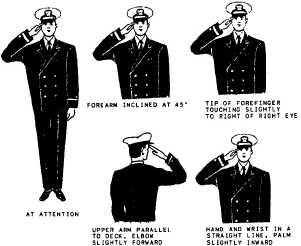| |
United States customs regulations explicitly
state that exemption from payment of duty for
articles purchased abroad covers only articles
intended for personal use of the returning traveler.
The term personal use as used in the regulations
refers to articles purchased with the traveler’s own
money, either for personal use or as a gift to others.
The import of large quantities of material, under any
agreement that permits transfer of goods after
importation, violates the regulations. Offenders are
liable to heavy fines as well as to imprisonment.
Travelers should keep an accurate record of
purchases made abroad so that they can make a
correct customs declaration. The prices actually paid
for articles purchased abroad, either in the currency
of the country where purchased or the equivalent in
United States currency, must be stated in the
customs declaration.
THE SALUTE
One of the essentials of military courtesy is the
salute. Regulations governing its use are founded on
military etiquette and, as such, are deeply rooted in
traditions and customs of the service. A military
organization functions efficiently only as a unit, and
any common bond or identifying symbol that furthers
the feeling of comradeship strengthens that unity.
The custom of saluting is a time-honored
demonstration of courtesy among military personnel
the world over. It expresses mutual respect and pride
in the military service.
In form, the salute is simple and dignified, but
that gesture has great significance. The privilege of
saluting is generally denied prisoners because their
status is unworthy of the comradeship of military
personnel.
The salute probably originated in the days of
chivalry, when knights in mail (flexible armor)
customarily raised their visors to friends for the
purpose of identification. Because of strict gradations
or rank, the junior was required to make the first
gesture. Another school of thought traces the salute
back to a custom at the time of the Borgias. Since
assassinations by dagger were common at that time,
men began approaching each other with raised hand,
palm to the front, to show they concealed no weapon.
In the American Navy, however, history
indicates that the hand salute came to use directly
from the British Navy. In the earliest days of British
military units, the junior uncovered when meeting or
addressing a senior. Gradually, the act of removing
the cap was simplified into merely touching the cap
or, if uncovered, the head (forelock). The act finally
evolved into the present form of salute.
PROPER MANNER OF SALUTING
Except when walking, stand at attention when
saluting. In any case, turn your head and eyes
toward the person saluted unless doing so is
inappropriate, such as when a division in ranks
salutes an inspecting officer on command. Raise the
right hand smartly until the tip of the forefinger
touches the lower part of the headgear or forehead
above and slightly to the right of the right eye. Join
and extend thumb and fingers. Turn the palm
slightly inward until the person saluting can just see
its surface from the corner of the right eye. Position
the upper arm parallel to the ground with the elbow
slightly in front of the body. Incline the forearm at a
45-degree angle with the hand and wrist in a straight
line. Complete the salute (after it is returned) by
dropping the arm to its normal position in one sharp,
clean motion. (See fig. 7-2.)
Execute the first position of the hand salute
when six paces from the person saluted, or at the
nearest point of approach, if more than six paces.
(Thirty paces is generally regarded as maximum
saluting distance.) Hold the first position until the
person saluted has passed or returns the salute.
According to naval custom, a word of greeting
should accompany the hand salute. The junior
Figure 7-2.-Hand salute.
7-11
|

